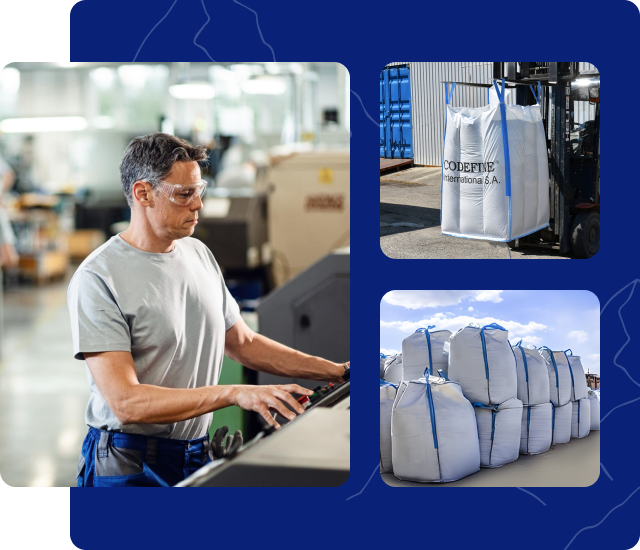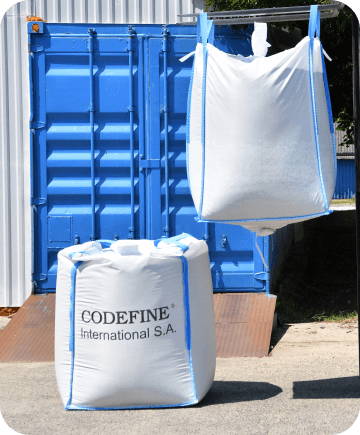Home » Posts Page » Blog » Products and Materials » The Role of Baffle Bags in Efficient Storage and Transport

Baffle bags are engineered as a sophisticated variant of standard FIBCs, featuring a distinctive internal structure that sets them apart from conventional bulk packaging solutions. What makes these containers unique is their incorporation of vertical fabric panels, known as baffles or internal walls, that are strategically positioned within the bag’s interior. These baffles are typically arranged in a grid pattern, connecting opposite sides of the container.
When empty, a baffle bag appears similar to a standard FIBC. However, the true differentiation becomes evident during the filling process. As material enters the container, the internal baffles restrict outward expansion, compelling the bag to maintain a more cubic or rectangular profile rather than assuming the typical cylindrical shape of standard bulk bags. This structural integrity is maintained throughout the filling process, resulting in a container with flat sides and defined corners.
The baffle construction typically utilizes the same durable polypropylene fabric as the outer shell, ensuring consistent material performance throughout the container. Connection points between baffles and outer walls are reinforced to withstand the considerable lateral pressure exerted by contents, particularly with dense or flowing materials.
Most baffle bags retain the standard FIBC features, top-loading spouts, bottom discharge options, and lifting loops, while adding the dimensional stability that makes them invaluable for space-critical applications. The design typically allows for customization in terms of dimensions, with common configurations offering heights between 3-7 feet and cross-sectional measurements that optimize container loading.
|
Feature |
Baffle Bags |
Standard FIBCs |
|
Shape when filled |
Rectangular/cubic |
Cylindrical/rounded |
|
Space utilization |
15-30% more efficient |
Less efficient with space gaps |
|
Stability when stacked |
High stability, flat surfaces |
Lower stability, rounded surfaces |
|
Container packing efficiency |
Near 100% utilization |
Typically 70-85% utilization |
|
Common applications |
Space-critical transport, automated systems |
General bulk transport |
|
Relative cost |
Higher initial investment |
Lower initial cost |
The engineering behind baffle bags delivers superior stability that addresses many challenges in bulk material logistics. The internal baffle structure prevents material shifting during transport, a significant advantage when handling granular or powder substances that would otherwise redistribute with movement and vibration. This stability is particularly valuable during intermodal transfers, where containers might be subjected to varied handling methods and orientation changes.
The rectangular profile also dramatically improves stacking capabilities compared to standard bulk bags. With flat surfaces meeting at defined corners, baffle bags create stable vertical columns when stacked, distributing weight evenly to the container below. This structural integrity allows for higher stacking configurations in warehouses, effectively increasing storage capacity without expanding physical footprint.
Load distribution within the bag itself is also optimized, with internal baffles preventing uneven settling that could compromise stability. This even distribution reduces stress concentrations on the container fabric, potentially extending service life while maintaining consistent dimensions throughout the logistics chain.
Perhaps the most compelling advantage of baffle bags is their remarkable space efficiency. The rectangular form factor aligns perfectly with the rectilinear geometry of shipping containers, trucks, and warehouse racking systems, virtually eliminating wasted space between packages.
When loaded into standard shipping containers, baffle bags can increase material capacity by 15-30% compared to conventional FIBCs. This efficiency translates directly to reduced shipping costs, fewer containers required for the same volume of material, or alternatively, more product shipped within existing container allocations.
In practical terms, a standard 20-foot shipping container might accommodate 10-12 conventional bulk bags due to their rounded profiles, creating unusable gaps. The same container could hold 14-16 comparably sized baffle bags, with their straight sides allowing for flush placement against container walls and adjacent bags. This optimization extends throughout the supply chain, from manufacturing facility to warehouse to end-user, compounding the efficiency gains at each stage.
The unique properties of baffle bags make them particularly valuable across several key industries:
In the agricultural sector, baffle bags excel in the transport and storage of grains, seeds, animal feed, and fertilizers. The stability prevents settling and potential germination issues with seeds, while maximizing warehouse storage density for seasonal inventory management.
Chemical manufacturers utilize baffle bags for powders, granules, and compounds where container shape consistency is critical for automated filling and dispensing systems. The maintained dimensions also facilitate precise inventory management, where exact space allocation is calculated based on package dimensions.
Food processing operations benefit from baffle bags for ingredients like flour, sugar, starches, and additives. The improved stability reduces the risk of package rupture, while the optimization of refrigerated or temperature-controlled storage space, often at a premium in food operations, provides immediate cost benefits.
Construction material suppliers leverage baffle bags for cement, sand, aggregates, and additives. The enhanced stacking capability is particularly valuable for building sites with limited storage footprints, allowing vertical utilization of space without compromising safety.
Pharmaceutical and nutraceutical manufacturers utilize baffle bags for raw materials, where maintaining shape integrity during transport prevents material compaction and quality issues.
While baffle bags offer numerous advantages, material compatibility remains an important consideration. These containers perform optimally with free-flowing dry materials that conform to the rectilinear shape without exerting excessive pressure on the baffles.
Granular materials like grains, pellets, and compounds are ideal candidates, allowing easy flow during both filling and discharge operations. Fine powders also perform well, though they may require additional considerations for dust control during handling.
Materials with higher moisture content or a tendency to clump may require specialized liners or coatings to prevent adhesion to the baffles, which could impede discharge. Similarly, extremely dense materials may necessitate reinforced construction to handle the increased weight and pressure on the internal structures.
Certain highly abrasive materials might cause accelerated wear on the internal baffles where material movement occurs during transport. In these applications, specialized abrasion-resistant fabrics or alternative container types might be warranted.
Selecting the appropriate baffle bag begins with a thorough assessment of load requirements. Like standard FIBCs, baffle bags are rated according to their Safe Working Load (SWL), typically ranging from 500kg to 2,000kg, depending on construction.
The safety factor, the ratio between breaking strength and SWL,is particularly important for baffle bags due to the additional stress points created by the internal baffle structure. Industry standards typically require a minimum 5:1 safety factor, meaning the bag should withstand five times its rated load before failure. For critical applications or hazardous materials, a 6:1 safety factor provides additional security.
When evaluating load ratings, consider not only the weight of materials but also the dynamic forces encountered during transport. Vibration, sudden stops, and lifting operations all introduce forces beyond static weight. The baffle structure actually provides an advantage here, as it limits material shifting that would otherwise create momentum-based stress on container seams.
Certification documentation should always accompany quality baffle bags, confirming testing to relevant standards such as ISO 21898 or EFIBCA guidelines. These certifications verify that the containers, including their specialized baffle structures, meet industry safety requirements.
Beyond basic load capacity, baffle bag selection should consider specific operational requirements that might necessitate specialized features:
For food-grade applications, FDA-compliant polypropylene fabrics and food-safe manufacturing processes ensure product safety. Many applications require PE liners for additional protection against contamination or moisture.
UV-stabilized fabrics extend service life for bags exposed to sunlight during storage or transport, preventing degradation that could compromise structural integrity, particularly important for the internal baffles.
Antistatic or conductive fabric options address safety concerns when handling materials that generate static electricity, reducing ignition risks in environments with flammable dust or vapors.
Discharge options vary widely, from standard spouts to specialized valves designed for controlled flow of specific materials. The baffle structure actually enhances discharge predictability by maintaining consistent internal geometry during emptying.
Printing capabilities allow for brand identification, handling instructions, or traceability information directly on the container surface, improving supply chain visibility and proper handling compliance.
Maximizing the benefits of baffle bags begins with proper filling procedures. Unlike standard FIBCs, which naturally assume a rounded shape, baffle bags require specific techniques to ensure optimal formation and stability:
Begin filling with the bag properly suspended by all lifting loops, ensuring even tension that allows the baffles to properly position themselves. The initial filling should proceed at a moderate rate, allowing the internal structure to gradually take shape without undue stress on connection points.
As filling progresses, periodic gentle shaking or vibration helps material settle uniformly around the baffles, preventing voids that could lead to later shifting. This is particularly important for fine powders or materials with varied particle sizes.
Fill to the appropriate level, typically 90-95% of nominal capacity, to allow proper closure while maximizing volume. Overfilling risks stressing the baffles and compromising the rectangular shape that provides the container’s key advantages.
Once filled, proper closure according to manufacturer specifications ensures containment integrity throughout subsequent handling. Many baffled bags feature specialized closure systems designed to maintain the rectangular profile at the top of the container.
The unique properties of baffle bags enable storage configurations that maximize space utilization, but proper techniques remain essential:
When stacking, align corners precisely to create stable vertical columns, distributing weight evenly across the lower bags. Most manufacturers specify maximum stacking heights based on material weight and bag construction; these guidelines should be strictly observed.
For warehouse storage, the consistent dimensions of baffle bags facilitate precise space allocation and inventory management. Their compatibility with standard pallet dimensions further streamlines handling in racked storage systems.
During transport, secure baffle bags to prevent sliding, particularly in partially-filled containers where unused space might allow movement. The rectangular profile provides natural stability, but additional securing measures ensure integrity throughout the journey.
For long-term storage, consider the effects of the environment on both the container and contents. While the baffle structure provides excellent stability, extended exposure to elements can affect material integrity. Where feasible, indoor storage provides optimal protection.
Codefine has established itself as an industry leader in specialized industrial packaging solutions, with a comprehensive range of baffle bags engineered to meet the most demanding logistics challenges. Our approach combines innovative design with rigorous quality standards, delivering containers that consistently outperform traditional bulk packaging options.
The Codefine difference begins with material selection. Our polypropylene fabrics undergo comprehensive testing for tensile strength, UV resistance, and durability, ensuring consistent performance throughout the product lifecycle. The critical baffle-to-wall connection points, often the most vulnerable areas in competitor products, feature reinforced stitching patterns developed through extensive field testing and engineering analysis.
Customization capabilities set Codefine apart in the baffle bag market. Our engineering team works directly with clients to develop specifications tailored to their exact requirements, optimizing dimensions for specific transport containers, adjusting baffle configurations for particular materials, and incorporating specialized features for unique operational environments. This collaborative approach ensures that each solution perfectly addresses the client’s logistics challenges.
For clients requiring comprehensive packaging systems, Codefine’s liner solutions integrate seamlessly with our baffle bags, providing additional product protection for moisture-sensitive or fine powdered materials. Our range of discharge systems, from simple spouts to complex valve configurations, ensures compatibility with any filling or emptying equipment.
By partnering with Codefine for your bulk packaging needs, you gain access not just to superior products but to a team committed to optimizing your entire material handling operation. Contact our specialists today to discover how our baffle bag solutions can transform your logistics efficiency and deliver meaningful cost reductions throughout your supply chain.
